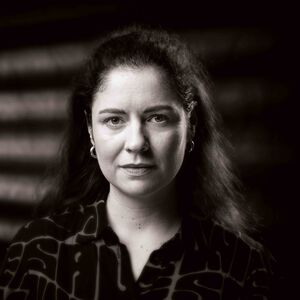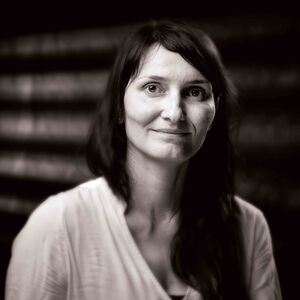-
Jela Krečič

Jela Krečič (1979) is a philosopher and writer. She has pub- lished two novels, Ni druge (None Like Her) (Beletrina, 2015) and Knjiga drugih (The Book of Others) (Beletrina, 2018). The first has been translated into English and German. In her theoretical opus she focuses on aesthetics, contemporary art and popular culture. In her professional and scientific articles and editorial work for journals, she has also researched classic Hollywood comedy and TV series. She was co-editor of the anthology Lubitsch Can't Wait (Slovenska Kinoteka, 2014), dedicated to the American director of German descent Ernst Lubitsch – and the work was also published in an edition of the German magazine Neue Rundschau. Her monograph Zmote neprevaranih: od modernizma do Hollywooda (Delusions of the Undeceived: From Modernism to Hollywood) (Društvo za teoretsko psihoanalizo, 2020) looks at contemporary art and popular culture. She also edited the volume The Final Count- down: Europe, Refugees and the Left (IRWIN, 2017). She has in recent years been lecturing at the University of Ljubljana and is currently employed as a researcher on the ARRS Slovenian Research and Innovation Agency project.
-
Jure Jakob

Jure Jakob (b. 1977 in Celje) studied philosophy and comparative literature in Ljubljana. In addition to poetry, he writes essays and children's books, and has also published a biography of the writer Lojze Kovačič.
Books of poetry, among others: Tri postaje (Three Stations, 2003), Zapuščeni kraji (Abandoned Places, 2010), Lakota (Hunger, 2018). In German: Werkstückchen, Litterae Slovenicae, Slovenian Writers' Union, 2019 (tr. Ann Catrin Bolton) and poems in the anthology Mein Nachbar auf der Wolke; Slowenische Lyrik des 20. und 21. Jahrhunderts (Carl Hanser Verlag & Deutsche Akademie für Sprache und Dichtung, 2023).
-
Jurij Devetak

Jurij Devetak (1997) is an illustrator and creator of comics from Trieste. After completing his studies in electrical engineering, he enrolled in the Scuola Internazionale di Comics in Padua, where he studied comic strips for three years. Since 2018 he has been collaborating with various newspapers and magazines. As an illustrator he contributed to the newspaper Dnevnik’s weekly supplement Objektiv for two years. Last year his first book, Nekropola v stripu (Necropolis as a graphic novel) (Mladinska knjiga, 2022), based on the famous autobiographical novel by writer and key figure in European culture Boris Pahor, was published. In May of this year, he published the comic for children Deva iz Devina (Deva from Duino) (ZTT, 2023), co-authored with the Slovene writer and poet Marko Kravos.
-
Lila Prap

Lila Prap (1955), writer and illustrator, Hans Christian Andersen Award and Astrid Lindgren Award nominee, has developed a recognisable, humorous style featuring her signature pastel on paper drawings. She gained international recognition and popularity with her series of children’s books 1001 pravljica (1001 Stories) (Mladinska knjiga, 2005), Moj očka (Daddies) (Mladinska knjiga, 2009), Dinozavri (Dinosaurs) (Mladinska knjiga, 2009), Pasji zakaji (Doggy Whys), (Mladinska knjiga, 2010) Mačji zakaji (Cat Whys), (Mladinska knjiga, 2013) and Zakaj? (Why?) (Mladinska knjiga, 2002; latest edition 2022). Her works have been translated into several world languages. The Japan National Television (NHK) based an entire cartoon series and accompanying merchandise on the characters from her books. Her picture storybooks from the Why? series encourage readers to seek answers to various questions with numerous nonsensical conclusions that always end up with the right, scientifically- proven answer.
-
Lucija Stupica

Lucija Stupica (b. 1971 in Celje), poet and interior designer, lives in Sweden. Books of poetry, among others: Čelo na soncu (Cello in the Sun, 2000), Otok, mesto in drugi (The Island, the City and the Others, 2008), Točke izginjanja (Vanishing Points, 2019). In German: Gedichte in der Anthologie Geburt eines Engels: Gedichte aus Slowenien, Wunderhorn, 2008 und in der Anthologie Mein Nachbar auf der Wolke; Slowenische Lyrik des 20. und 21. Jahrhunderts (Carl Hanser Verlag & Deutsche Akademie für Sprache und Dichtung, 2023).
-
Maja Gal Štromar

Maja Gal Štromar (1969) is an all-round artist, actress, poet and writer, translator, theatre pedagogue, playwright and director. She studied Romance languages and also attended the Jacques Lecoq International School of Theatre in Paris. She has played over 90 roles in theatres at home and abroad, 33 in films. She has published four poetry collections Goga 66000, Na predpomlad mi reci ti (Call Me By My First Name Before Springtime), Že češnječas (It's Cherry Time), Boginja z zamudo- Dea in ritardo (Belated Goddess, poetry collection with a CD), seven novels, the theatrical monodrama Alma Ajka, published in Slovene and Arabic at the Biblioteca Alessandrina in Egypt, a children's story about the theatre Črkolandija (Letterland), the fairy tale Anina Zvezdica (Anna's Little Star) and a theatre manual Od besedila do uprizoritve (From Text to Staging). She writes theatre and radio plays for children and adults. In 1991 she won the Sever Award for her acting. Recently she has been working on a monodramedy Absurdania d.o.o. Notable among her novels are Amigdalino srce (Amygdala’s Heart) (Litera, 2003), Misli name, ko ti je lepo (Think of Me in the Good Times) (Mladinska knjiga, 2011), Potaknjenci (Cuttings) (Goga, 2014), and Ženska drugje (Woman Elsewhere) (Goga, 2017).
-
Maja Haderlap

Maja Haderlap (1961) was born in Železna Kapla/Bad Eisenkappel in Carinthia, Austria. She graduated in theatre studies and German at the University of Vienna. For a number of years she was co-editor of the Carinthian Slovene literary magazine Mladje. After theatre assistantships in Trieste and Ljubljana, she was head of dramaturgy at the Klagenfurt Civic Theatre for a decade and a half. She also lectured at Klagenfurt University. She now lives in Klagenfurt as a freelance writer. Her poems were first published in Slovene literary magazines. In 1983 she published her first poetry collection Žalik pesmi (Salige Gedichte) (Drava, ZTT), followed in 1987 by the collection Bajalice (Wünschelruten) (Drava, ZTT). In 1998 her extensive collection Gedichte Pesmi Poems (Drava) was published, containing also poems written in German for the first time. Her 2011 novel Engel des Vergessens (Angel of Oblivion) (Wallstein, 2011) brought her important literary awards including the Ingeborg Bachmann Prize, in 2014 she published the poetry collection langer transit (distant transit) (Wallstein), and in 2023 her novel Nachtfrauen (Night Women) (Suhrkamp, 2013).
-
Maja Kastelic

Maja Kastelic (1981) is an academically trained painter, illustrator and author of picture books for children. After completing her degree in painting at the Art Academy in Ljubljana, she continued her studies with a MSc in Philosophy and Visual Culture Theory (Faculty of Humanities Koper). She worked for a number of years as a restorer of frescos, since 2015 she has worked exclusively as an illustrator. She has received numerous awards and prizes for her work, among others the Biennial of Illustration Bratislava (BIB) Plaque and the IBBY Honours List. She was included in the Illustrators Exhibition selection at the 2015 Bologna Children's Book Fair, and twice in the White Ravens Catalogue by the International Youth Library (A Boy and a House, 2015; First Love, 2016), and her illustrations have been exhibited at numerous curated selections. Her picture book Deček in hiša (A Boy and a House) (Mladinska knjiga, 2015) impressed readers and the professional public both at home and abroad and was also made into a puppet play (LGM Maribor Puppet Theatre, 2017). She works with some of the most notable Slovene and foreign publishing houses and translations of her picture books have been published all around the world. Notable among her illustrations are also the books Pravljično potovanje Hansa Christiana Andersena (The Fairy- tale Journey of Hans Christian Andersen) (Mladinska knjiga, 2021) and Adam in tuba (Adam and His Tuba) (Miš, 2022).
-
Manica K. Musil

Manica K. Musil (1974) was born in Ptuj and initially wanted to study the piano. She soon turned her attention to other areas, including architecture. After graduating, her first building won the international Grand Prix at the “Leonardo” competition for young architects in Minsk, 2005. She also won several prizes for her graphic works, and her designs have featured on 11 postage stamps from Slovenia. After the birth of her first child, she expanded her creativity and began writing stories and poems for young children. Between 2011 and 2022, she published 15 children’s books at various renowned Slovene publishing houses, also achieving widespread international recognition. Her most translated books include Slon Stane (Stan the Elephant) (Pivec, 2017), Lev Izidor (Robbie the Lion) (Pivec, 2021), Mravljičnar Franc (Franky the Anteater) (Pivec, 2019), Pobalinska pujsa (The Naughty Pigs) (Pivec, 2015) and Trije mucki in zmaj (Three Kittens and a Dragon) (Pivec, 2020). She has won numerous book and illustration prizes at book fairs around the world.
-
Maruša Krese

Maruša Krese (b. 1947 in Ljubljana, d. 2013) studied literature, art history and psychotherapy in Ljubljana and the USA. She worked as a psychotherapist in Ljubljana, London and Tübingen, and later as a journalist and freelance artist in Berlin.
In 1997 she received the Cross of Merit of the Federal Republic of Germany for her humanitarian commitment during the Bosnian war.
Bilingual editions: Selbst das Testament ging verloren, Edition Korrespondenzen, 2001 (tr. Klaus Detlef Olof), Yorkshire Tasche, Wieser, 2003 (tr. Brigitte Struzyk) or Heute nicht, Drava Verlag, 2009 (tr. Fabjan Hafner). In German: the novel Trotz alledem will be published by S. Fischer Verlag in 2023 (tr. Liza Linde) and poems in the anthology Mein Nachbar auf der Wolke; Slowenische Lyrik des 20. und 21. Jahrhunderts (Carl Hanser Verlag & Deutsche Akademie für Sprache und Dichtung, 2023).









 RSS
RSS
